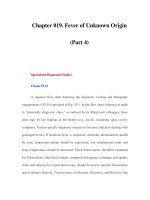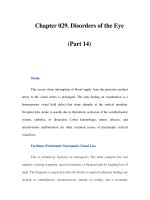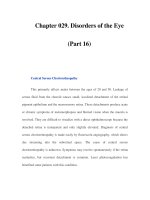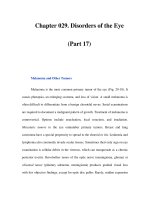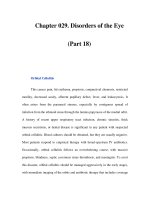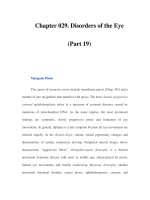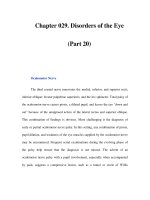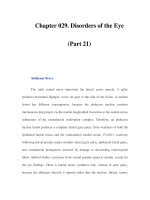Chapter 085. Neoplasms of the Lung (Part 4) pptx
Bạn đang xem bản rút gọn của tài liệu. Xem và tải ngay bản đầy đủ của tài liệu tại đây (13.89 KB, 5 trang )
Chapter 085. Neoplasms of the Lung
(Part 4)
Inherited Predisposition to Lung Cancer
While an inherited predisposition to develop lung cancer is not common,
several features suggest a potential for familial association. People with inherited
mutations in RB (patients with retinoblastomas living to adulthood) and p53 (Li-
Fraumeni syndrome) genes may develop lung cancer. First-degree relatives of
lung cancer probands have a two- to threefold excess risk of lung cancer or other
cancers, many of which are not smoking-related. An as yet unidentified gene in
chromosome region 6q23 was found to segregate in families at high risk of
developing lung cancer of all histologic types. Finally, certain polymorphisms of
the P450 enzyme system (which metabolizes carcinogens) or chromosome
fragility (mutagen sensitivity) genotypes are associated with the development of
lung cancer. The use of any of these inherited differences to identify persons at
very high risk of developing lung cancer would be useful in early detection and
prevention efforts.
Therapy Targeted at Molecular Abnormalities
A detailed understanding of the molecular pathogenesis should be
applicable to new methods of early diagnosis, prevention, and treatment of lung
cancer. Two examples of this translation involve EGFR and vascular endothelial
growth factor (VEGF). EGFR belongs to the ERBB (HER) family of
protooncogenes, including EGFR (ERBB1), Her2/neu (ERBB2), HER3 (ERBB3),
and HER4 (ERBB4), cell-surface receptors consisting of an extracellular ligand-
binding domain, a transmembrane structure, and an intracellular tyrosine kinase
(TK) domain. The binding of ligand to receptor activates receptor dimerization
and TK autophosphorylation, initiating a cascade of intracellular events, leading to
increased cell proliferation, angiogenesis, metastasis, and a decrease in apoptosis
(Chap. 80). Overexpression of EGFR protein or amplification of the EGFR gene
has been found in as many as 70% of NSCLCs.
Activating/oncogenic mutations (usually a missense or a small deletion
mutation) in the TK domain of EGFR have been identified. These are found most
commonly in women, East Asians, patients who have never smoked, and those
with adenocarcinoma and BAC histology. This is also the group of patients who
are most likely to have dramatic responses to drugs that inhibit TK activation
[tyrosine kinase inhibitors (TKIs)]. EGFR mutations are almost never found in
cancers other than lung cancer, nor in lung cancers that have KRAS mutations.
These EGFR mutations, often associated with amplification of the EGFR gene,
usually confer sensitivity of these lung cancers to EGFR TKIs (such as gefitinib or
erlotinib), resulting in clinically beneficial tumor responses that unfortunately are
still not permanent. In many cases the development of EGFR TKI resistance is
associated with the development of another mutation in the EGFR gene (T790M
mutation), or amplification of the c-met oncogene. However, other drugs with
EGFR TKI activity are in development to which the lung cancers with these
resistance mutations will respond as are drugs targeting c-met or its pathways.
The discovery of EGFR mutation/amplification driving lung cancer growth
and the dramatic response of these tumors to oral EGFR TKI therapy has
prompted a widespread search for other drugs "targeted" against oncogenic
changes in lung cancer. An important example of another such target is VEGF,
which, while not mutated, is inappropriately produced by lung cancers and
stimulates tumor angiogenesis (Chap. 80). VEGF is often overexpressed in lung
cancer, and the resulting increase in tumor microvessel density correlates with
poor prognosis. A monoclonal antibody to the VEGF ligand, bevacizumab, has
significant antitumor effects when used with chemotherapy in lung cancer (see
below).
Molecular Profiles Predict Survival and Response
Just as the presence of EGFR TK domain mutations and amplification is an
excellent predictor of response to EGFR TKIs, molecular predictors of response to
standard chemotherapy and other new targeted agents are being sought. Lung
cancers can be molecularly typed at the time of diagnosis to yield information that
predicts survival and defines agents to which the tumor is most likely to respond.
One example is the identification of alterations in lung cancer DNA repair
pathways that may predict resistance to chemotherapy. Patients whose tumors
exhibit low activity of the excision-repair-cross complementation group 1
(ERCC1) proteins typically have a worse prognosis as they are unable to repair
DNA adducts in the tumor. However, retrospective analysis shows that when
treated with cisplatin, patients with tumors expressing low levels of ERCC1
activity appear to do better, as they are unable to repair DNA adducts caused by
cisplatin, while patients with high ERCC1 activity actually do worse with
cisplatin-based chemotherapy. Although these protein or gene expression
"signatures" have yet to be validated in large prospective studies, it is possible that
such information will allow future therapy to be tailored to the characteristics of
each patient's tumor. Mass spectroscopy-based proteomic studies have identified
unique protein patterns in the serum of patients, one of which allows for early
diagnosis, while another can predict sensitivity or resistance to drugs. However,
such methods have not been validated and may be difficult to implement in a
patient care setting.

